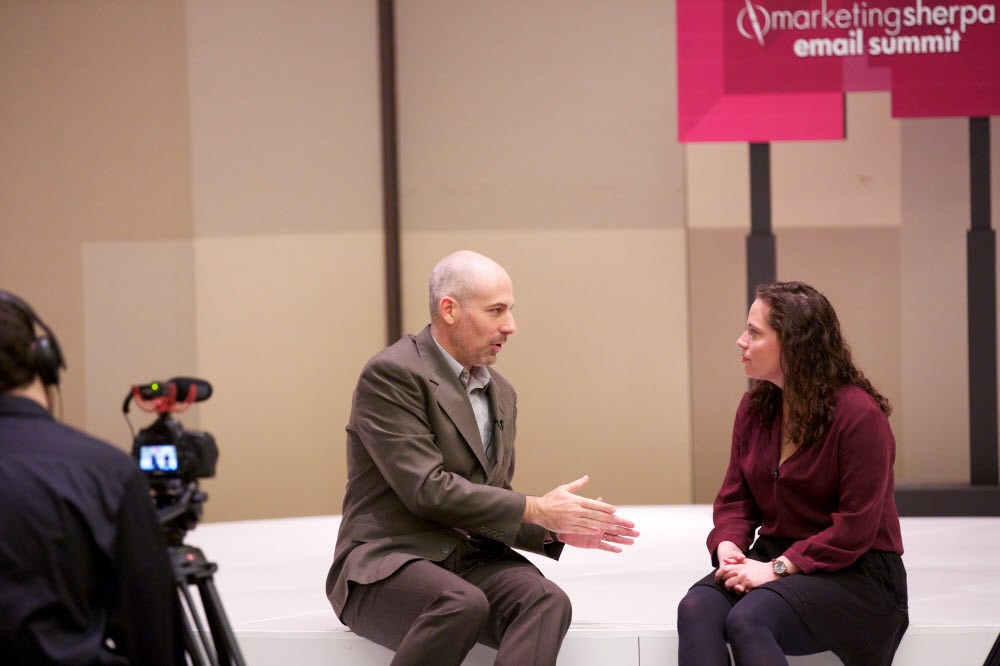Three Takeaways on Customer-Centric Marketing from Email Summit 2015 Media Center
There are a lot of decisions that go into putting on Email Summit. Millions, probably, if you go deep enough.
But they all come around with one objective: you. The attendees and people who are reading about, and following, the event.
In every discussion and decision, we were asking ourselves how it would affect the experience. Your experience. So it made sense that when it came time to pick speakers and give out the Email Summit Awards, sponsored by BlueHornet, that customer-centric campaigns were the ones that rose above the rest.
Fellow Email Awards judge Daniel Burstein, Director of Editorial Content, MarketingSherpa, and myself sat down on the steps of the (still under-construction) 2015 Email Summit Media Center to discuss some of our award winners and the customer-centric elements of campaigns featured at the Summit.
“The companies that focused on customers, that put their customers first, are the ones that ultimately have the sustainable competitive advantage,” Daniel said.
Our marketing compass points toward true customer-centricity, so it was important that marketers we featured held that same standard.
Daniel spoke about the B2B Award winner he has been working with over the past few months, Ferguson, and one of their main takeaways from their own event effort: Always look to enrich the customer experience.
Ferguson Enterprises generated more than $10 million and growing in online sales by enriching the customer experience within their 90 trade show events, which allowed Ferguson’s vendors to get in front of customers and promote their brands and products.
To accomplish that, Ferguson went from one email per event to a segmented series as well as optimized its onsite event registration for better retargeting.
Read the full case study here.
We also spoke about a great takeaway from Readers’ Choice Award Winner Microsoft Store: Don’t wait for the perfect situation to start understanding customers.
After Microsoft launched physical, brick-and-mortar stores, the decision was made to bring the online and brick-and-mortar businesses together as a single business initiative.
Unfortunately, within the initial data sets the marketing team had, there was very limited customer information. This fragmented start led to a legacy of separate and multiple systems that were used to collect data, making it hard to understand customers across both areas.
Additionally, because different systems were used, the marketing team collected different points of data from customers depending on where they purchased their products.
“They didn’t just wait until they had it all in place to get things done. For example, one tactic they did that every marketer out there can do today — they went to their frontline customer service people to see what their customers really wanted, and that helped impact what kind of content they delivered,” Daniel said.
Instead of waiting for a long-term dynamic data infrastructure, the team worked within their current confines to learn more about their consumers and make the most out of the limited data to increase email revenue by 600%.
Read the full case study here.
Another great example is Kentucky Derby, with this top takeaway: Develop a relationship with customers in order to keep them engaged.
The Kentucky Derby has a unique challenge — keeping customers engaged year-round for a once-yearly main event.
Hindering this was that the team was marketing based on assumptions about their customers. Wanting to put some concrete data behind the content choices the marketing team was making, they began segmenting their newsletter and directing content to customer personas who would find it the most compelling.
Read the full case study here.
The main lesson to be learned from all of this though, and what we’ve learned from working closely with these marketers (and many, many others) leading up to Email Summit, has been that email should be a conversation.
Data from a study MarketingSherpa commissioned last month discovered that a large majority of U.S. adults — a whopping 72% — prefer communication with companies to happen through email.
So you see, people want to communicate with you, but they need it to be worthwhile and engaging.
You can watch our interview together here:
Follow the rest of Email Summit 2015, and listen to your marketing peers detail how they were able to accomplish this goal in their own email programs. From there, challenge yourself to improve the conversation.
If you liked to learn all of the top takeaways from Email Summit 2015, stay tuned to the MarketingSherpa Email Marketing Newsletter. An event recap with everything you need to know will be published in the coming weeks.
You can follow Courtney Eckerle, Manager of Editorial Content, MarketingSherpa on Twitter at @CourtneyEckerle.
You might also like
Marketing Research Chart: How do customers want to communicate? [MarketingSherpa Chart of the Week]
Digital Marketing: Content marketing, social media, and SEO predictions for 2015 [More from the blogs]
Email Marketing: List segmentation tips using social media and online behavior [More from the blogs]
Essential Elements of Email Marketing: Experts interviewed from Email Summit 2014 [More from the blogs]
Categories: Consumer Marketing customer-centric, Email Marketing, email summit, Media Center, personalization











Thank you so much for relaying this information for those of us who couldn’t be there!